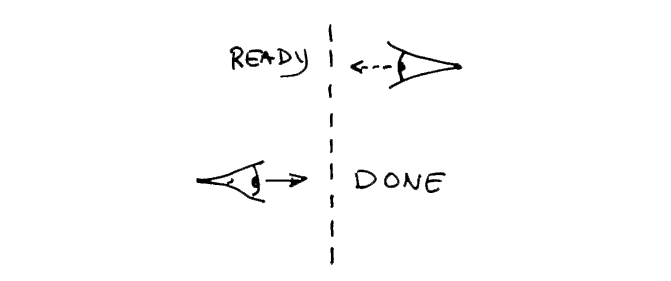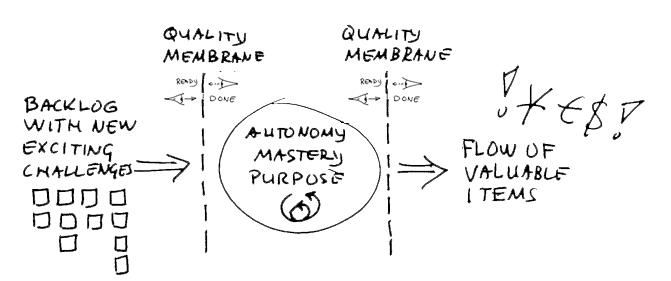Scrum has much ado about Definition of Ready and Definition of Done.
The Definition of Ready for the current phase equals the Definition of Done for the previous. Likewise, the Definition of Done for the current phase equals the Definition of Ready for the next. They are the two sides of the same membrane.

So, why not simplify it and talk about the membrane only?
Ready and Done form the coupling plane between any to phases. Within the phase, if you look to the previous phase its coupling plane, you see stuff Ready for you to pick up and do. You add your value, whatever that is, and evolve and develop it into the Done state, so that it becomes Ready for the next.
The unidirectional membrane between two adjacent phases acts like a quality filter.
Membrane quality filters aggregate—they add up as development progresses. So, at any point in its evolution, products will show the sum of all previous quality filters. Just like the nesting of matrushka dolls, where each larger doll transcends and includes all previous dolls.
Each value adding cell in this evolutionary chain has its own values, principles, talents, governance, rhythm, velocity, rules, rituals, working agreements, needs and desires. It knows best how to divide up the inflowing work and transform it into valuable, shippable items ready and valuable for the next phase.
The cell itself excels in Autonomy, Mastery, and Purpose—so they are AMPs, if you will; they amplify by adding value. It only needs to be fed with a continuous stream of new, exciting challenges that match its talent and can pass through the quality membrane, both front and rear.

Since each cell is autonomous and has its own production capacity, chances are that it can absorb more work than the previous cell can produce, sucking the backlog empty. It can also produce more than the next in line can absorb, creating a, potentially huge, reservoir that can clog the system as a whole.
So, care must be taken to design and tune these elements so that their impedances closely match. Feedback loops, both short and long, and with varying buffer capacity, keeps these backlogs in check. Careful design, a shunt here and there, keeps the system from jittering and oscillating, creating a smoothly running, green and lean value production machine.

GIGO—Poor quality membranes allow you to feed a cell with garbage. The cell will happily try to add value to that garbage. However, working on garbage confuses the cell and slows it down. Unclear about what to do, but still committed to do, it creates more garbage. If many membranes in the system have similar, poor quality, and with the proper feedback loops, the system will enter a negative spiral of garbage in, garbage out.
QIQO—Lucky for you, the opposite is also true. Quality feeds quality, creating an upward spiral of ever more value creation. Quality in, quality out. So you’d better make sure that your membranes are top quality itself.
Initially, it’s important that you have a quality membrane, not what it is. As the evolutionary line itself matures, getting better in getting better, all membrane quality filters tighten up, further boosting quality. That is, the membrane quality filter themselves evolve, too.
However, talking about membranes may elude to the dreaded handover. So, how about eliminating these membranes altogether? Let’s simply connect any two AMPs with a stream, and putting a sign next to the stream listing its quality.
What’s your take on:
- Ready to Poker;
- Ready to Develop;
- Ready to Build;
- Ready to Test;
- Ready to Accept; and
- Ready to Ship.
And let’s drop ‘Defintion of Done’ completely.
